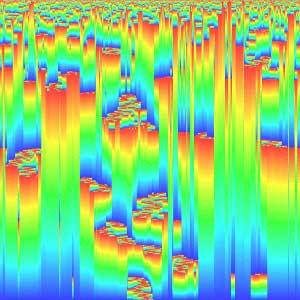.
Bak-Sneppen model

Sample of Bak Sneppen model evolution: on the x axis the population status, on the y axis (from top to the bottom) the history of the population. The discontinuities represents an evolution.. (*)
The Bak-Sneppen model is a simple model of co-evolution between interacting species. It was developed to show how self-organized criticality may explain key features of the fossil record, such as the distribution of sizes of extinction events and the phenomenon of punctuated equilibria. It is named after Per Bak and Kim Sneppen.
The model dynamics repeatedly eliminates the least adapted species and mutates it and its neighbors to recreate the interaction between species. A comprehensive study of the details of this model can be found in Phys. Rev. E 53, 414-443 (1996). A solvable version of the model has been proposed in Phys. Rev. Lett. 76, 348–351 (1996) , which shows that the dynamics evolves sub-diffusively, driven by a long-range memory.
An evolutionary local search heuristic based on the Bak-Sneppen model, called "extremal optimization," has been introduced in Artificial Intelligence 119, 275-286 (2000).
References
* Bak, P. (1996). How Nature Works: The Science of Self-Organized Criticality. New York: Copernicus. ISBN 0-387-94791-4.
* Bak, P. and Kim Sneppen (1993). "Punctuated equilibrium and criticality in a simple model of evolution". Physical Review Letters 71: 4083–4086. doi:10.1103/PhysRevLett.71.4083.
* Kim Sneppen (1992). "Self-organized pinning and interface growth in a random medium". Physical Review Letters 69: 3539–3542. doi:10.1103/PhysRevLett.69.3539.
Links
* Bak-Sneppen Evolution Model as an interactive java applet.
Retrieved from "http://en.wikipedia.org/"
All text is available under the terms of the GNU Free Documentation License


